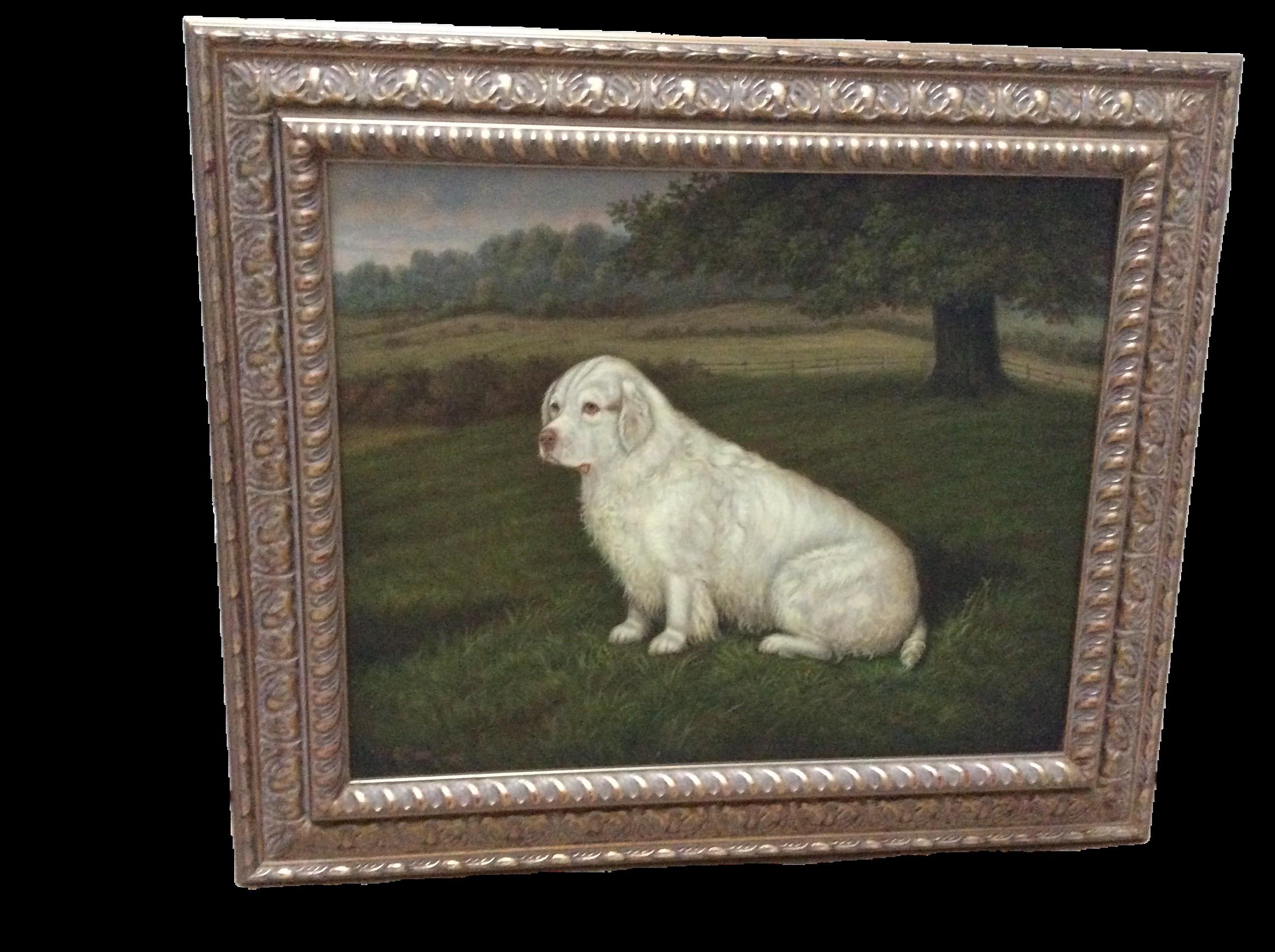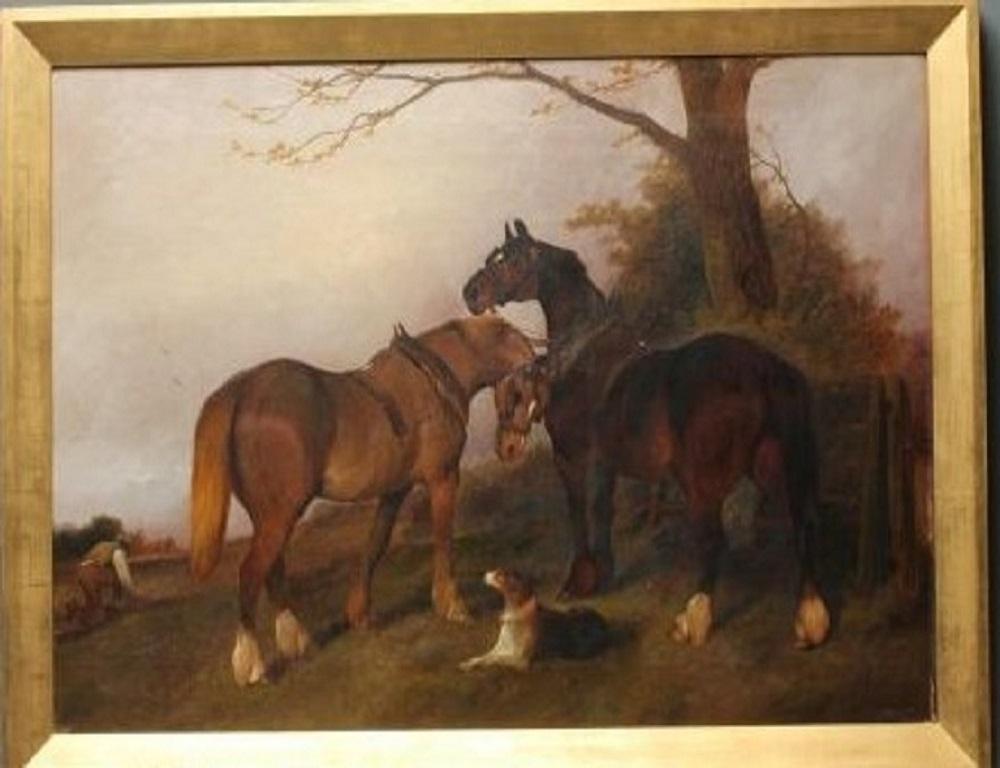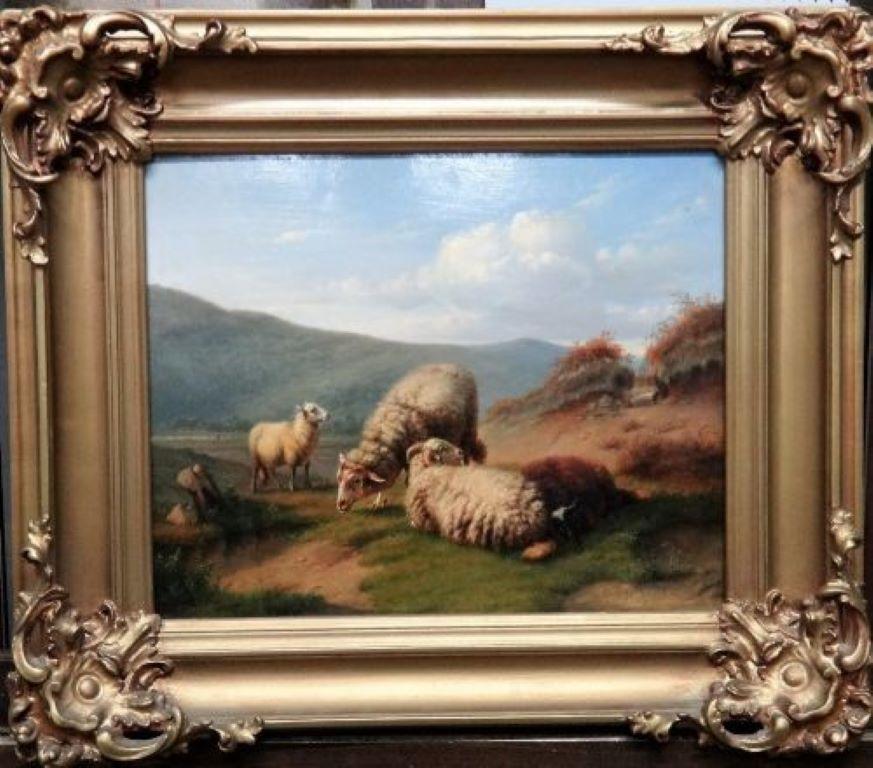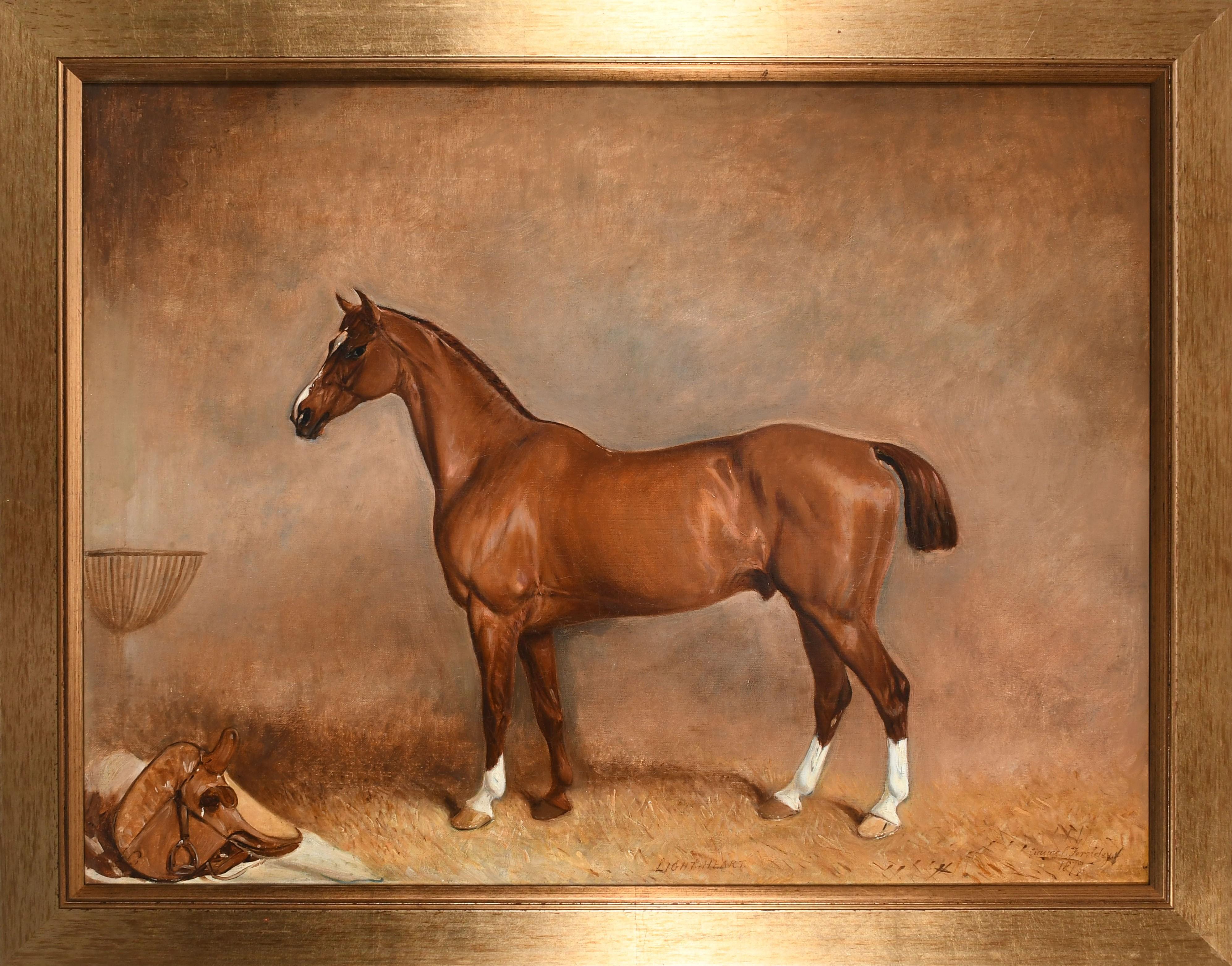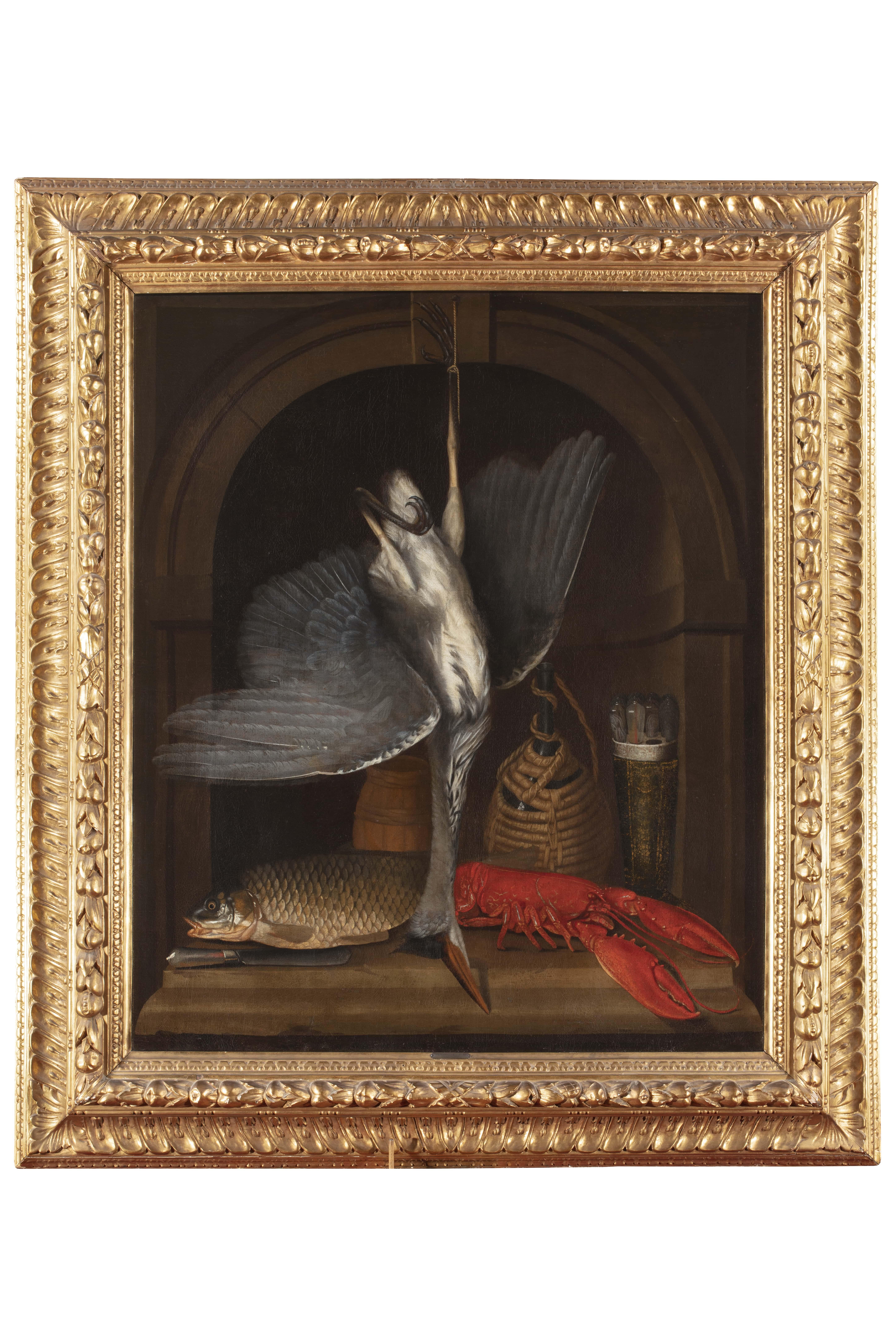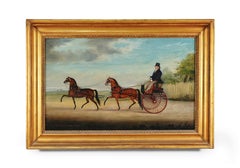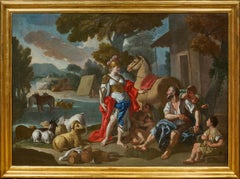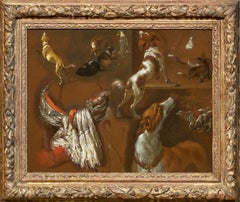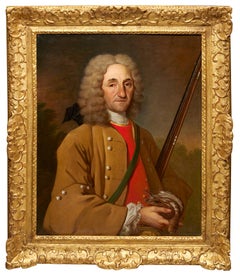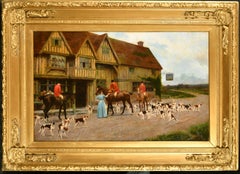
19th century, Horse, dogs, hunting scene oil Frank Proschwitzry Freyburg
Want more images or videos?
Request additional images or videos from the seller
1 of 8
Frank Proschwitzry Freyburg19th century, Horse, dogs, hunting scene oil Frank Proschwitzry Freyburg1893
1893
About the Item
- Creator:Frank Proschwitzry Freyburg (1862 - 1940, German, British)
- Creation Year:1893
- Dimensions:Height: 31.11 in (79 cm)Width: 40.95 in (104 cm)Depth: 4.34 in (11 cm)
- Medium:
- Movement & Style:
- Period:
- Condition:In very good condition ready to hang.
- Gallery Location:York, GB
- Reference Number:1stDibs: LU1800210735872
About the Seller
5.0
Vetted Seller
These experienced sellers undergo a comprehensive evaluation by our team of in-house experts.
Established in 1991
1stDibs seller since 2022
13 sales on 1stDibs
Typical response time: 8 hours
More From This SellerView All
- John Sanderson Wells , oil, horses, horse riding country sceneBy John Sanderson-WellsLocated in York, GBA fine oil painting by the renowned artist John Sanderson Wells " Returning from a Country Ride" This painting captures beautifully the image o...Category
Early 20th Century Old Masters Animal Paintings
MaterialsOil
- horse & carriage/gig , country scene, antique oil, by John Vine of ColchesterLocated in York, GBA fine antique oil painting, on canvas, of horses pulling a tandem at speed. signed and titled lower left, Vine Colchester 1834 This fine painting shows two horses pulling an open carriage /gig with gentleman in extensive landscape/park The size of the painting is approx 50 x 80 cms, whilst overall the size framed is 100cm x 71 cm This is a fine painting in very good condition housed in a gilt frame ready to hang Provenance: The E. W. Towler Collection, formerly of Glympton Park, Woodstock, Oxfordshire see details below The artist John Vine was born with a disability that did not appear to interfere with his ability to draw and paint, largely self-taught as an animal painter, as his reputation grew he exhibited at the Society of British Artists in Grosvenor Square. Based at Colchester he painted many different subjects including farms, houses, children and animals. Eric W. Towler was a remarkable man. He was born in 1900 and left school at the age of 12 to work in a Yorkshire pit and through a lifetime of hard work, self-improvement, luck and a refusal to limit his horizons achieved many of his aspirations. As a Yorkshireman through and through, he believed in ‘spending the brass in his pocket’ and over time he was successful enough to acquire enough ‘brass’ to enable his purchase of Glympton Park and furnish it as a traditional country house with all the trappings – in his case collections of...Category
Mid-19th Century Old Masters Animal Paintings
MaterialsOil
- William Albert Clark, clumber spaniel, dog, oil painting.By William Albert ClarkLocated in York, GBstudy of a seated clumber spaniel, oil on canvas, signed and dated 1929 lower left. Housed in a new gilt frame. Paintings of these beautiful dogs are...Category
1920s Old Masters Animal Paintings
MaterialsOil
- HENRY FREDERICK LUCAS LUCAS, horse in stable, oil, 19th centuryBy Henry Frederick Lucas LucasLocated in York, GBBeautiful oil on canvas, study of a horse in stable.Housed in a gilt frame signed and dated 1886 lower right The size being 60 x 44 cm. whilst overall 75 x 60 cm Provenance: The contents of a Cheshire Country House. Presented in very good condition. HENRY FREDERICK LUCAS LUCAS...Category
Mid-19th Century Old Masters Animal Paintings
MaterialsOil
- 19th century Landscape, country horses, dog ploughing George WrightBy George WrightLocated in York, GBGEORGE WRIGHT Plough Team horses and a Dog in a Landscape, oil on canvas A fine painting from the renowned equine artist George Wright. This oil on canvas depicts the 2 horse plough ...Category
19th Century Old Masters Animal Paintings
MaterialsOil
- Sheep In A Landscape, 19th Century, Follower Of Eugene VerboeckhovenLocated in York, GBA fine painting of sheep in a landscape setting follower of the talented Belgium painter of animals Eugene Verboeckhoven. Housed in a 19th century gilt frame. The size overall being 55 cm x 48 cm whilst the painting is 38 x 29 cm. The sheep have been beautifully captured especially their faces. An oil on board study ready to hang Eugene Joseph Verboeckhoven...Category
19th Century Old Masters Animal Paintings
MaterialsOil
$3,225 Sale Price20% OffFree Shipping
You May Also Like
- Herminia and the Shepherds, a painting by Francesco de Mura (Napoli 1696 - 1782)By Francesco de MuraLocated in PARIS, FRIn this masterly painting, Francesco de Mura presents the meeting of Herminia and the shepherds, a famous episode taken from the seventh canto of Torquato Tasso's Jerusalem Delivered...Category
1760s Old Masters Figurative Paintings
MaterialsCanvas, Oil
- Ten dog studies and a study of a stole, a panel attributed to Jan WeenixBy Jan WeenixLocated in PARIS, FRThis painting is typical of the art of Jan Weenix, one of the best still life and hunting painters of the Dutch Golden Age. In a cleverly disordered manner, he depicts ten studies of dogs (mainly spaniels and greyhounds) and the sumptuous study of a stole. These studies were probably intended to be used as a source of inspiration and adapted in the painter's compositions, as we will see in a close examination of some of his paintings. 1. Jan Weenix, a prolific still life painter Jan Weenix was born into a family of artists: his father Jan Baptist Weenix (1621 - 1659) was also a landscape and still life painter and his mother Josyntgen d'Hondecoeter was the daughter of the animal painter Gillis d'Hondecoeter (1575 - 1638). His father trained him together with his cousin Melchior d'Hondecoeter (1636 - 1695). In 1664 Jan Weenix became a member of the St. Luke's Guild in Utrecht, to which he belonged until 1668. In 1679 he married Pieternella Backer with whom he had 13 children. His compositions, often related to hunting (still lifes, portraits of hunters) were very successful, ensuring him a certain financial ease. Jan Weenix also painted large-scale decorations: while staying in Düsseldorf with the Prince-Elector of the Palatinate between 1702 and 1712, he executed twelve gigantic compositions combining landscapes, hunting scenes and still life for the Bensberg hunting lodge. 2. Description of the artwork The painting displays a great apparent disorder that hides a rigorous organisation in four quarters. It presents ten studies of hunting dogs and one study of a stole. The studies of the stole and of two of the dogs (the greyhound in the lower right and the spaniel in the upper right quarter) are quite elaborate, whereas those of the other dogs are sketchier. As an example, the dog in the upper right corner is only partially painted. The dogs' coats, of different colours - brown, sandy, grey or black - stand out against the warm brown background and are illuminated by the shine of their white hair. This white colour, probably executed with ceruse white, illuminates the study of a stole which stands out in the lower left-hand corner while the red colour of its lining warms up the composition. The purpose of this stole is enigmatic: we think it is probably a neckband, but it could also be the back of the turban of an oriental character. To the right of this stole is the outline of a long animal leg, perhaps a horse leg. Similar studies are rare in the work of Jan Weenix, but the Rijksmuseum recently acquired the study of a seated monkey. This study, executed in the same brown chromatic range, is much more accomplished. It has been reused with minimal change in many compositions. It is likely that Jan Weenix had less frequently a monkey at his disposal, and that he therefore depicted it in great details, whereas he could probably easily find dogs as models. Note the characteristic white dot in the corner of each pupil that brings them to life! 3. Related artworks We have tried to relate the various dogs in this study to the countless dogs that appear in the paintings of Jan Weenix, as listed in the catalogue 'Father and Son - Weenix' compiled by Anke van Wagenberg- Ter Hoeven in 2018. A first example is the painting entitled "The Prodigal Son on the Steps of a Palace" (catalogue number 7 - 8th photo in the gallery). In the lower left-hand corner of the composition, a spaniel is barking at a peacock perched on a stone. This spaniel, which is depicted in a similar manner in the "Portrait of a Young Man with a Falcon" in the Bremen Kunsthalle (catalogue number 76), is reminiscent of the spaniel in the upper left-hand quarter of our study (although the latter is slenderer and the direction of its head differs). We also find, in a slightly different pose, the seated greyhound that is at the top of our painting in the composition representing "A Swan, a Stag, a Hare and Birds presented by two hunting Valets" (catalogue number 130 - last photo in the gallery). The sketch of this greyhound in our study is unfinished: the painter only painted the grey undercoat and the white parts of the coat, without completing the sandy coat which appears in the final painting. We can see from these various examples that our study was probably more a repertoire of forms than a model for a specific composition. The painter probably used it for inspiration before adapting each dog study...Category
Late 17th Century Old Masters Animal Paintings
MaterialsOak, Oil
- Portrait of Julien Prieur as a hunter - Circle of Jean-Baptiste Oudry 1686-1755By Jean-Baptiste OudryLocated in PARIS, FRThis portrait depicts us the trusted confidant of the Conflans d'Armentières family. More precisely, Julien Prieur was the fiscal procurator of the Marquisate of Armentières, playing the role of representative of the "public ministry", safeguarding the interests of his lord. His role, one can imagine, was crucial at the death of Michel de Conflans (in 1717) since the latter left an heir, Louis, aged only 6, and a widow, Diane Gabrielle de Jussac, whom some memoirs describe as "a very clever grande dame" . Prieur ensured the smooth running of the family's affairs and it is probably to thank him for his services that Diane Gabrielle had his portrait painted, most probably by a painter close to Jean-Baptiste Oudry. Julien Prieur appears as he is, middle-aged, with a benevolent look, in his hunting suit. Only his knotted wig links him to the nobility. Above all, he is depicted as a hunter, a passion that he shared with the Marquis of Armentières. His very young master, Louis, became a first-rate hunter, hunting in the King's entourage, in whose cabinet he died of apoplexy in January 1774. As for the his son, he was one of Louis XVI's closest hunting companions, as numerous souvenirs attest . 1. Some biographical information about the model and the commissioner While the identity of many 18th century portraits is uncertain, an old label stuck on the reverse of the canvas gives us some precise information on the identity of the model: "Mr. Julien Prieur, homme d’affaires de Mr. le Marquis d'Armentières - Commune of Brécy - Aisne". The label also suggests that it could be his son Louis Prieur living in Rocourt (probably Rocourt-Saint-Martin, a neighbouring municipality of Brécy), born on 30 September 1745, who died on 8 July 1826, but this hypothesis must be rejected in view of the model's clothing. This label probably gives us an indication on the previous owner the owner of this painting; we will see later why it seems likely that this label was affixed between 1826 and 1832. Brécy is now a municipality in the Aisne County (Hauts-de-France) located between Soissons and Château-Thierry, slightly north of the Paris-Reims axis. It borders the municipalities of Armentières-sur-Ourcq and Rocourt-Saint-Martin. According to Louis Prieur's death certificate, he was in fact born in 1743 and not in 1745 . The age of the model in the painting and the dating of this painting would indicate that Julien Prieur, was probably born at the very end of the 17th century. In Louise-Marthe de Conflans-Coigny, chatelaine de Brécy , we read that "the Conflans were a family of ancient nobility, which genealogists trace back to the 12th century, when it was said to have come from the house of Brienne. In the 16th and 17th centuries, this family had several illustrations in the profession of arms. [...] Michel de Conflans, [...] belonged to a younger branch of the family, of which Saint-Simon wrote, with his acid soaked pen, that "poor and obscure, they had never left their village, where their house resembled a hut" and elsewhere that they "lived on their rifles and cabbages". Fortunately for Michel de Conflans, the last representative of the elder branch, Henriette d'Armentières, made him her heir on her death in 1712. It was through her that the land of Armentières and its 14th century castle became part of the estate of this branch, as well as, not far from there, the land of Brécy and the castle of Le Buisson, where the family lived. In the early years of the 18th century, Michel de Conflans was able to push himself into the entourage of the Duke of Orleans, becoming his first gentleman of the chamber. However it was above all his son Louis who restored the family status through his military career. Born on 23 February 1711, Louis de Conflans, Marquis d'Armentières died of apoplexy on 18 January 1774, in the King's cabinet at Versailles. Appointed lieutenant general in 1746, he received his Marshal of France’s stick in 1768. The Dictionary of French Biography writes of him that "without ever achieving a high command, he appeared with honour in all the wars of his time". The estates of Armentières and Le Buisson were sequestered during the French Revolution, declared national property and sold at auction (in 1794 and 1795 respectively) after the Marquise d'Armentières, the Marshal's second wife, was beheaded in 1794. The Château du Buisson (where Michel de Conflans died in 1717) was bought by a granddaughter of the Marshal de Conflans, the Marquise de Coigny, in 1816 and remained in her family after her death in 1832 until the sale of the 1,054 hectares estate in 1866. The bayonet blows that probably pierced the canvas in three places may well have a revolutionary origin and it is conceivable that the painting, acquired by the Marquise de Coigny from Louis Prieur, Julien's son, after the latter's death, was then restored and given the label specifying the name of the model. 2. Description of the portrait The painting presents a man in his thirties in his hunting costume. Pictured at mid-body, his face is marked by his life in the open air and characterised by a look of great bonhomie. Holding a rifle under his elbow, he is soberly dressed in a large caramel-coloured jacket, decorated with silver buttons. Presented in a three-quarter view, the model holds a partridge in his right hand. The jacket opens onto a vermilion waistcoat. A green shoulder strap probably holds a powder flask hidden under his arm while a satchel is visible on his belt. The model is wearing a grey wig, tied at the back with a black ribbon that seems to fly in the wind. This ornament anchors Julien Prieur in his time. "The new King of France, Louis XV, [imposed] a style of smaller wigs for men and the rigorous white or preferably greyish powdering. From the middle of the century men also used a ponytail on the back of the neck, tied with a ribbon, a style that became very popular in all courts." He stands out against a dark, purplish sky at the end of an autumn day in a soberly sketched forest landscape. The treatment of the sky recalls the influence of Largillière, Oudry's first master. 3. Jean-Baptiste Oudry Jean-Baptiste Oudry was born on 17 March 1686 in Paris, rue de la Ferronnerie. He began his apprenticeship around 1705-1707 with Nicolas de Largillière, with whom he stayed for five years. In 1713 Oudry established his "livre de raison" in which he reproduced all his early works in wash drawings up until 1718. During this first period which lasted about 7 years, Oudry produced works of great diversity, both in the genres that the artist tackled and in the artists which influenced him. It has been estimated that he painted about 150 pictures during this period: mainly portraits, but also still lifes and some religious paintings and landscapes. Of the hundred or so portraits that Oudry is said to have painted during this period, only fifteen have been identified today. A number of those lost portraits are probably still confused with works by Largillière. First admitted to the Académie de Saint-Luc in 1708, he was then allowed to join the Académie Royale in 1717, and subsequently admitted as a history painter in 1719. This year marks a turning point from which Oudry will assert himself as an animal painter. In 1723 he met Louis Fagon, Intendant of Finances, and the Marquis de Beringhen, the King's first equerry, who became both friends and patrons of the artist, giving him access to royal commissions and enabling him to be appointed as painter of the Royal Tapestry Factory of Beauvais in 1726. From 1728 onwards, the creation of tapestries became the core of his work, even though at the same time Oudry developed his skill as an illustrator, first for Scarron's Roman Comique and then for La Fontaine’s Fables. Between 1726 and 1731, Oudry created the decoration of a large drawing room at the château de Condé-en-Brie, about twenty kilometres from Brécy, which has remained in place to this day. This important commission, about which few details are known, is said to have originated with the Countess de Verrüe, a great lady of the French Regency who often stayed at Condé with her friend Jean-François Leriget, Marquis de la Faye, then owner of Condé. A prolific artist, Oudry fulfilled numerous commissions in parallel with his regular contributions to the Salons, to which he regularly took part until 1753. He suffered a stroke in 1754 and died the following year. It seems almost certain, in view of the importance of his work, that Oudry supervised a workshop in which several artists were involved, but this point is very poorly documented. Given the geographical proximity of Brécy and Condé-en-Brie, the links between the Armentières family and the Condé patrons, and finally based upon the quality of our portrait, we propose the hypothesis that it was painted by one of the painters who worked with Oudry at Condé. 4. Related artworks: comparison with some other portraits of hunters by Jean-Baptiste Oudry While Oudry gradually abandoned portraiture from 1720 onwards to devote himself to animal paintings, he seems to have made an exception for hunter portraits, which were often depicted in the company of their hunting dogs. Two examples seem particularly evocative and suggest a dating for our painting around 1730. We will see in a second part why this dating proposal seems relevant. The first portrait worth mentioning is the presumed portrait of Lieutenant Claude-André Courtin de Crouey, lord of Quatre Fils and Cormeilles-en-Parisis made in 1723, reproduced below. Also presented in a very tight frame, it is interesting for the similarities in the representation of the rifle, and in particular the two metal rivets that are almost identical in our painting. The painting that seems closest to ours is the presumed portrait of Monsieur...Category
1730s Old Masters Portrait Paintings
MaterialsCanvas, Oil
- 17th century By Dutch maestro Still life with bird, carp & lobster Oil on canvasLocated in Milano, LombardiaThis painting fits well into the Dutch pictorial production of the Golden century. The composition, built on the harmonious presentation of rich wild game and fine details such as th...Category
17th Century Old Masters Still-life Paintings
MaterialsCanvas, Oil
- Study of a dogLocated in Amsterdam, NLStudy of a dog Oil on paper laid down on panel, 17.5 x 25.5 cm Provenance Private collection, the Netherlands Note: We are grateful to Mr Fred Meijer for his attribution to Ludolf de Jongh Ludolf de Jongh was the son of a shoemaker. When his father moved to Rotterdam, the young Ludolf decided to learn art rather than shoemaking and became a pupil of Cornelis Saftleven. Later he studied under Anthony Palamedes in Delft and still later with Jan van Bijlert in Utrecht. In 1635 he travelled to France with Francis Bacon. Seven years later, in 1642, he returned to the Netherlands when he heard that his mother had fallen ill. He set up a shop in Rotterdam, and his earliest signed paintings date from that year. According to Houbraken, his travels had caused him to speak French so fluently, that his parents had to learn French in order to speak with him. De Jongh’s work shows a strong influence from the Utrecht school of Caravaggio admirers, especially Jacob Duck...Category
Mid-17th Century Old Masters Animal Paintings
MaterialsPaper, Oil, Wood Panel
- Antique oil painting, Boy Fleaing a Dog, Gerard ter Borch, Dutch golden ageLocated in DEVENTER, NLGerard ter Borch (II) (1617-1681), copy after, around 1700 'Boy Fleaing a Dog' Oil on canvas Professionally restored (cleaned and relined) In modern frame in 17th century style Dimensions excl. frame: 33 x 27,5 cm. Dimensions incl. frame: approx. 50 x 45,5 cm. Depcited is a boy busy fleaing a dog. The boy sits on a chair with the dog on his lap. On a table on the right there is a book and a pen. On a wooden bench lies the boy's hat. What is unique about this painting by Ter Borch, is the relationship that is depicted between human and animal. Mostly animals like dogs where depicted as an attribute in paintings in the 17th century, and sometimes used to symbolize certain character traits. This boy is lovingly caring for his dog, which he is giving his full attention. Another interesting detail is that Ter Borch's brother Moses, was probably the model for this painting. Ter borch often used family members as models for his paintings. Moses was also a very talented painter and draughtsman. Several copies of this work by Ter Borch are known. One of these copies is in the collection of the Dutch Rijksmuseum (Image included in the image gallery (last image)). The original painting is in the collection of the Alte Pinakothek museum in Munich, Germany. Gerard ter Borch, also known as Gerard Terburg, was a Dutch genre painter who lived in the Dutch Golden Age. He influenced fellow Dutch painters Gabriel Metsu...Category
Early 18th Century Old Masters Interior Paintings
MaterialsOil, Canvas
$3,260 Sale Price20% Off
Recently Viewed
View AllMore Ways To Browse
19th Century Horse
Framed Horse Oil
Old Horses
1893 Painting
Animals Dogs
19th Century Art Horses
Franks Oil Painting
19th Century Hunting
Frank Oil Paint
Shipping Animals
Hunting Paint
Hunting Frame
19th Century Animal Oil Paintings
Paintings With Dogs
Hunting Sign
19th Century Oil Paintings Of Animals
Horse Show Paintings
Animals Hunting





